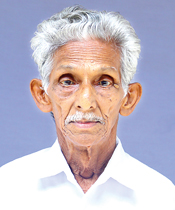Preparing ‘Aluth Avurudu nekath’ for the Dalada Maligawe

E.M.D. Wettewe
With the transition of the sun from the Meena Rashiya (the house of Pisces) to the Mesha Rashiya (the house of Aries), Sri Lanka celebrates the dawn of the Sinhala and Tamil New Year which is a solar festival. While the main Buddhist religious festivals are Vesak and Poson which fall on Poya (full moon) days according to the lunar calendar, the Sinhala New Year is connected with the sun, the solar system and is also known as the Soorya Mangalya.
This year the Aluth Avurudda or Bak Maha Ulela – the Sinhala and Tamil New Year will be celebrated on April 14. The Tamil New Year –Puthandu is also celebrated by Hindus all over the country.
It is Vasantha Samaya, the season signifying fertility, celebrated even by many other countries of the world as spring festivals. Celebrated after the Maha season harvest, it is a form of thanksgiving and enjoyment, a period of rest for the farming community.
There are many religious rituals and cultural practices which are followed by the people. Nekath (auspicious times) are calculated and prepared by astrologers to perform these rituals. In Buddhism there is no mention of nekath and the Sinhala Avurudda is not a religious festival although people visit the temple during the nonagathe or Punya Kalaya, the transition period from the old to the New Year. During this time people involve themselves in religious activities.
During the reign of the Malabar Nayakkar kings in the Kandyan Kingdom, the Aluth Avurudu celebration was given a religious appearance. There are four important festivals celebrated every year at the Sri Dalada Maligawa–the Alut Sahal Mangalya, Alut Avurudda, Esala Perahera and the Karthika Mangalya. E.M.D. Wettewe, has worked in the Dalada Maligawa in Kandy for 20 years and during the past 15 years has prepared the Nekath for the Maligawa.
Speaking to the Sunday Times, he explained how he makes the Aluth Avurudu nekath for the rituals to be conducted in the Dalada Maligawa. “According to history, during the reign of king Kirthi Sri Rajasinha, the Most Ven. Welivita Saranankara Maha Sangha Raja Thera requested the king to combine the four Hindu devala perahera with the Sri Dalada Maligawa perahera. Since then to-date, the Raja Ana -king’s command to make the nekath for the devala and Maligawa continue as a sampradaya– tradition.”
“The Nekath Rala had to be very careful in preparing the nekath. If anything went wrong, the King’s wrath was shown by taking drastic action against him!”
“Unlike an astrologer preparing nekath for weddings, domestic and personal requirements when the person’s date and time of birth is taken into consideration, the Avurudu nekath for the Dalada Maligawa has to be made according to the sampradaya, keeping in mind the daily rituals of the Sri Dalada Maligawa such as the Buddha pooja and Nanamura Mangalya on Wednesdays. These rituals cannot be disturbed,” he explained.
“The Maligawa will observe certain Aluth Avurudu rituals such as boiling of milk, lighting the hearth, making sweetmeats and preparing the special oil for anointing at the Natha Devalaya. But the nekath for the dana poojawa and hisa thel gema – anointing are done differently. Every day the dana is offered between 9.45 and 10.45 am. Therefore, on the day of the Aluth Avurudda, a suitable nekatha is made to offer the dana keeping in mind the sampradaya (traditional) time of the normal offering. A special nekatha is also made on Wednesday for the nanamuramangalya to coincide with the hisa thel gema, anointing with nanu, medicinal herbs and leaves mixed with oil.”
“The oil for the Natha devalaya for hisa thelgæma and distribution to the other devalas is prepared at the Sri Dalada Maligawa under the direction and supervision of the Kariyakarawana Korala.The oil is sent to the Natha devalaya two days before the Thel gæmé uthsavaya for its use and distribution to the other devala.”
The dates and times for the Avurudu rituals are mentioned in the Avurudu Seettuwa. This includes bathing in the Parana Avurudda (old year), the interim period, the punya kalaya or nonagathé when people cease their work and visit the temple for religious observances. Cooking the first meal in the new year, anointing with medicinal oils and leaving for work are all performed according to the auspicious time and a specific colour of clothing is mentioned to be worn to perform these rituals.
The village temple plays a major role during the Sinhala New Year. A bell is rung in the temple to alert the villagers and indicate the auspicious time for each new year ritual.
Viewing of the new moon is on the 16th, bathing in the parana avurudda (old year) is on the 12th. Hisa thel gæma (anointing) is on the 17th. On the 19th, one is advised to leave for work.
On the 14th the hearth is lit for the New Year and kiribath (milk rice) is cooked in a new pot.Milk is boiled in a pot with the family members sitting around, to see it spill over, considered a good sign for prosperity.
The kamatha (threshing floor) is used for the traditional village games. The arrival of the Avurudu Kumaraya (New Year Prince) attired in grand clothes made of the colour meant for that particular year, is believed to be the dawn of the New Year. On his arrival, one could see the excitement of the people and hear the joyous exclamation “Avurudu Kumaraya Avilla.”
All these Avurudu rituals are performed for prosperity, happiness and with fervent hopes of peace for the people and the country.



